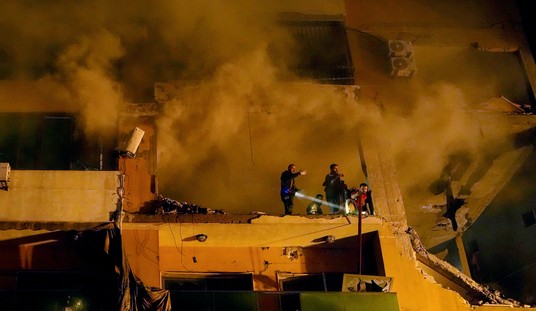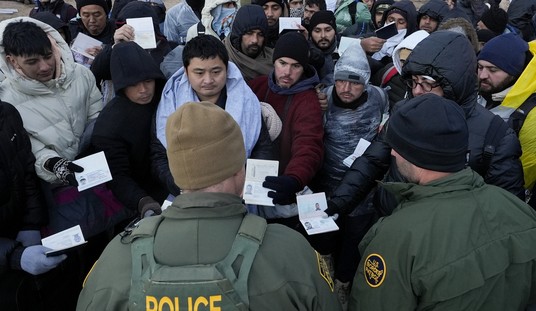California continues to go full speed ahead on its high-speed rail project connecting Los Angeles and San Francisco, as construction starts far away from either end of the system in the Central Valley. The engineers have arrived to start the first 30-mile leg to and from a city that few will want to visit on the line, and the locals aren’t exactly impressed. In fact, they’re getting angrier as the project slowly rolls forward:
Now, engineering work has finally begun on the first 30-mile (48-kilometer) segment of track here in Fresno, a city of a half-million people with soaring unemployment and a withering downtown core littered with abandoned factories and shuttered stores.
Rail is meant to help Fresno, with construction jobs now and improved access to economic opportunity once the project is finished. But the region that could benefit most from the project is also where opposition to it has grown most fierce.
“I just wish it would go away, this high-speed rail. I just wish it would go away,” says Gary Lanfranco, whose restaurant in downtown Fresno is slated to be demolished to make way for rerouted traffic.
Such sentiments can be heard throughout the Central Valley, where roads are dotted with signs such as: “HERE COMES HIGH SPEED RAIL There goes the farm.” Growers complain of misplaced priorities, and residents wonder if their tax money is being squandered.
Aaron Fukuda, a civil engineer whose house in the dairy town of Hanford lies directly in one of the possible train routes, says: “People are worn out, tired, frustrated.”
Voters in 2008 approved $10 billion in bonds to start construction on an 800-mile (1,300-kilometer) rail line to ferry passengers between San Francisco and Los Angeles in 2 hours and 40 minutes, compared with 6 hours by car now during good traffic.
Except that’s not the apposite comparison. The correct comparison would be to other mass-transport systems, and the fact is that the route already has service — through the airlines. At least a half-dozen airlines fly that route each day, with multiple departures and arrivals through multiple airports throughout both endpoint metropolises. The costs of those flights cost less than the full projected cost of a round-trip ticket on the 160-minute train ride, and gets there in less than half the time. There is almost literally no need for this boondoggle except to aggrandize the politicians wasting taxpayer money by laying track adjacent to and across the West’s largest earthquake fault.
No one’s really sure what the end costs will be, either. A recent estimate scaled the final price tag back from $100 billion to $68 billion, but for a state in chronic debt, it’s still monopoly money:
Since then, the housing market collapsed, multibillion-dollar budget deficits followed, and the price tag has fluctuated wildly — from $45 billion in 2008 to more than $100 billion in 2011 and, now, $68 billion.
And that cost “savings” comes at the expense of the train’s supposed speed, too:
Political and financial compromises led officials to scale back plans that now mean trains will be forced to slow down and share tracks in major cities, leading critics to question whether it will truly be the 220-mph (355-kph) “high-speed rail” voters were promised. …
Even the former chairman of the California High-Speed Rail Authority, Quentin Kopp, has turned against the current project, saying in court papers that it “is no longer a genuine high speed rail system.”
Dan Walters pointed out in last week’s Sacramento Bee that the new specs for the project no longer meets the bond initiative’s language. This sets up a test of integrity that California and Governor Jerry Brown are failing:
Legal maneuvers aside, it’s quite evident that the project, as modified by Brown’s handpicked High-Speed Rail Authority to overcome other political and financial hurdles, cannot comply with the plain language of the bond ballot measure – language that bullet-train proponents told voters would protect the project’s integrity.
Having been integrated with commuter rail in major urban areas, for example, the bullet train could not possibly comply with the requirement of a 160-minute ride between San Francisco andLos Angeles, even if authorities insist otherwise.
Clearly, Brown, et al, hope that if they can stave off legal challenges long enough to lay a few miles of track on San Joaquin Valley farmland, it would create some kind of moral imperative to see the project to completion, regardless of the law or its costs, now pegged at $68 billion but certain to grow.
Ultimately, however, it’s a test of political integrity – especially in light of recent polls showing that most California voters now oppose the project. If the bullet train cannot honestly comply with the requirements that voters were told would guard against flim-flam, it should be derailed.
It never should have been “railed” in the first place, but Walters is right. This project has become an even bigger joke, one with a price tag that will haunt generations of Californians simply to feed the 19th-century, fixed-rail thinking of politicians. It’s insanity manifest large in the Golden State.







Join the conversation as a VIP Member